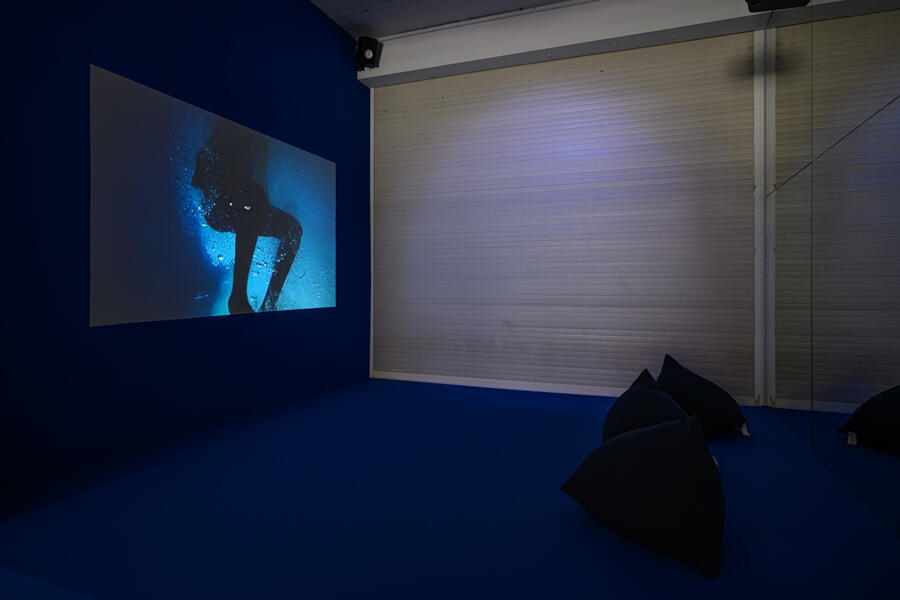‘NEXUS’ Offers a One-Way Portal to Caribbean Video Art
An exhibition of video work at MoCA Taipei highlights the affinities between the regions but also the logistical hurdles that prevent full reciprocal exchange
An exhibition of video work at MoCA Taipei highlights the affinities between the regions but also the logistical hurdles that prevent full reciprocal exchange

Undulating upon a wall of cerulean blue, lithe adolescent boys tumble through Circa no future (2016), a portal of a film by St. Vincent and the Grenadines-based artist Nadia Huggins. Washed of the presumptions and expectations that accumulate on the skin of Black men – the body plunged through the skin of the ocean, flung beyond the reaches of the land – it offers new horizons for the interpretation of identity beyond the constructs of race and national sovereignty.
The alchemy at the heart of Huggins’s film is central to the work of ‘NEXUS’, a survey of video work by Caribbean artists at MoCA Taipei, and the first show in Taiwan to focus exclusively on the region. Despite certain affinities – on top of sharing histories of colonization, four of the 13 nations that recognize Taiwan’s independence are Caribbean – exchange between the two regions has been limited, partly due to obstacles imposed by Western nations and institutional misunderstanding of these issues. As the Taiwan-based Haitian-American curator Jean-Paul Weaver told me in conversation, such constraints have in the past necessitated lengthy visa applications and extremes such as zigzagging international flights to circumvent the US for Haitian artists coming to Taiwan, to avoid penalties or even incarceration – an option no longer even feasible due to Russia’s invasion of Ukraine. In fact, with ‘NEXUS’ having a mere three-week proposal window, only the show’s Dutch curator, Sasha Dees, was able to travel to the island: none of the participating artists were in attendance.

Given such restrictions, the works on view offer portals between such distanced regions. Foreign in a Domestic Sense (2021) – a collaboration between Puerto Rico-based Sofía Gallisá Muriente and Natalia Lassalle-Morillo – examines how engagement with Caribbean identity is mediated by the US. The film gathers testimony from migrant Puerto Ricans in Central Florida and lingers on both the burden of assimilation following displacement, as well as the immense tenderness found in reaching beyond place toward community. The closing scene captures a rainy slow dance in a Floridian swamp, fingers reaching beyond raincoats to cup familiar faces.

While the militaristic zeal that the US applies to the administration of its borders may be a comfort in a push for sovereignty for many in Taiwan, for others, it is an aggressive reminder of sovereignty opposed. The unflinching footage of Haitian artist Maksaens Denis’s multi-channel work Mes Rêves / My Dreams (2021) immerses viewers in throngs of masked protestors as they overwhelm the streets of Port-au-Prince. It is a panorama easily legible to Taiwanese audiences, who are well-versed in interpreting similar scenes from locales not so far-flung (think Hong Kong). In other moments, Denis repeatedly pounds his forehead into his camera like a bloody metronome – seemingly in a desperate attempt to crack through this final portal of the screen – pausing only when he has to be patched up with sutures.

Its significance and good intentions notwithstanding, circumstances around ‘NEXUS’ still evidence the logistical legacies of colonialism and the predatory visa regulations that still strand and immobilize Black and Brown bodies. Community-building, particularly in racially homogenous environs like Taiwan, does not end with art: more protracted entanglements are key. In the absence of these artists, as Weaver puts it, ‘the life force of the political statements within these works is lost’. To ensure Caribbean-based practitioners have the opportunity to contribute in full to ongoing artistic discourse, Taiwanese institutions must understand the issues these artists face when travelling and operate on timeframes that can accommodate them. Only then can we summon a portal to truly reciprocal exchange.
‘NEXUS – Video and New Media Art from the Caribbean’ is on view at MoCA Taipei until 16 July.
Main image: Sharelly Emanuelson, Siudadanos, 2015, installation view. Courtesy: MoCA Taipei; photograph: ANPIS FOTO





















